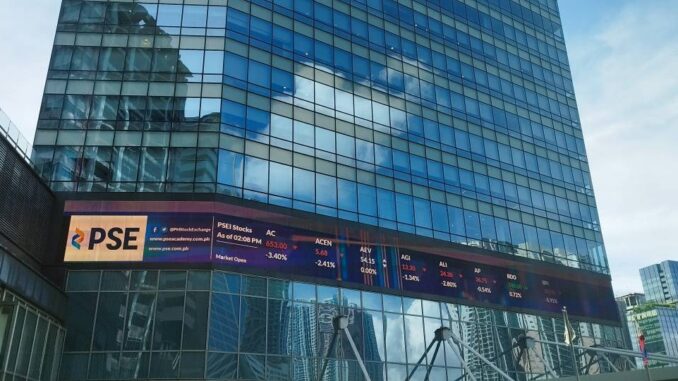
CAPITAL raising activities at the Philippine Stock Exchange Inc. (PSE) this year will still be lower than in 2023, but the bourse is optimistic of a rebound in 2025.
“[T]his year, we will hit around P90 to P100 billion,” PSE President and CEO Ramon Monzon told the Manila Times last week.
“I think next year, at least… P150 [billion].”
At a recently concluded Manila Times forum, Monzon said that P76.84 billion had so far been raised as of October through three initial public offerings (IPOs), one stock rights offering, six follow-on offerings (FOOs), and seven private placements.
At least another P11.7 billion could follow for the rest of this year, including one IPO, three FOOs, and one stock rights offering.
This would bring to 2024 total to at least P88.54 billion, down from the P140.95 billion recorded in 2023.
Cebu-based Top Line Business Development Corp. has received regulatory approval for a P2.87-billion IPO next month, which will be the fourth such listing this year following OceanaGold (Philippines) Inc., Citicore Renewable Energy Corp., and NexGen Energy Corp.
Three FOOs, meanwhile, are forthcoming from Arthaland Corp. (P3 billion), DITO CME Holdings Corp. (P1.97 billion) and Steniel Manufacturing Corp. (P315 million). Arthaland and DITO are set to list their follow-on offerings next month, while details for Steniel’s FOO have yet to be released.
Phinma Corp., lastly, is planning to raise P1 billion via a stock rights offering to fund its business unit projects and investments in new ventures.
Monzon said that some of the IPOs next year could include GCash, which recently saw a boost in valuation after Japan’s Mitsubishi Corp. increased its stake, and Maynilad Water Services Inc., which is mandated by virtue of its concession agreement to go public on or before 2027.
“We know some big names — Gcash is later in the year, but you have Maynilad,” he said. “A few other big companies [have] talked to us… sometimes it’s not the number, it’s the capital raising that I’m looking at.”
Philstocks Financial Inc. research manager Japhet Tantiangco told the Times that “assuming we can get back on track, I believe the P150-billion [capital-raising] target is possible.”
“In the end, aside from the need for funds, issuers will check if there’s strong appetite from investors,” he added.
Investor confidence will have to be boosted, and “we would need to see continuous positive developments in the general economy,” Tantiangco continued.
Unicapital Group research head Wendy Estacio-Cruz, meanwhile, said “we believe the P150B capital-raising target by the Philippine Stock Exchange is achievable if inflation and interest rates further decline next year.”
“This should encourage companies to finance expansions through equity markets, which tend to perform better in such environments,” she added.
“We expect at least 2-3 IPOs next year, potentially reaching 6, excluding SROs and FOOs,” she continued, noting that “a key risk to policy rate reduction is a potential escalation of geopolitical tensions.”
Luna Securities president Francis Diaz, meanwhile, said that “more products on the shelves can only be a good thing.”
“There are many interesting companies out there that could take advantage of the capital markets and, in turn, be invested in by the public,” he added.
Market conditions will be a key driver, Diaz continued, and he noted that “markets are currently in a better position than from six, 12 months ago, and with more interest comes the potential for better valuations.”
The listing process, however, is “somewhat daunting,” and Diaz said that the bourse could consider some tweaks.
“Listing on the exchange comes with many responsibilities, pre- and post-IPO, and there may be wisdom in auditing the current process and requirements. I think technology can be a big help here,” he said.
Last week, Monzon said that the bourse was still among the most attractive in the region despite the decline in capital-raising activities.
“As of October 18, the dividend yield index, composed of the top 20 dividend-paying companies, grew by 29.6 percent year-to-date, while the mid-cap index, which includes the top 20 mid-sized companies, also rose by 29 percent year-to-date,” he said.
As of September, meanwhile, average daily value turnover was said to have increased to P6.23 billion, up 2.2 percent compared to the P6.09 billion average in 2023.
“At the same time, the market has also shifted to a net foreign buying position, amounting to 4.74 billion pesos, which is a turnaround for the 53.65 billion net foreign selling during the end of 2023.”
The PSE, however, continues to lag other Asian bourses in terms of the number of listed companies and value turnover, which Monzon said were indicators of low liquidity.
Despite having 1.9 million individuals registered as stock market investors compared to 1.1 million individuals with time deposit accounts, value turnover for the first half only amounted to P1.384 trillion compared to time deposit accounts totaling P5.628 trillion.
He said that lower bank interest rates could drive funds to the stock market and added that new products could attract more investors.
The PSEi, which earlier this month hit an over four-year high of 7,554.68, fell to a low of 7,283.79 on Thursday but recovered some ground to close the week at 7,314.24.


Be the first to comment